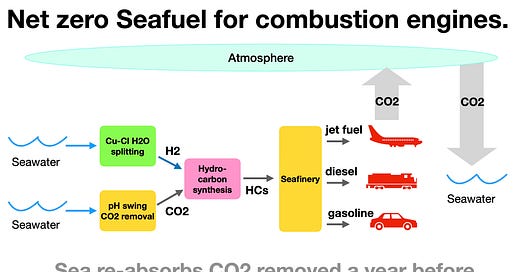New nuclear fission power plants can generate energy inexpensively because they achieve high temperatures, opening up more options. Hot heat can reduce the costs of hydrogen to $1/kg using technologies such as the copper-chlorine cycle or solid oxide electrolysis cells.
The ocean absorbs atmospheric CO2 to a density 140 times that in air. A seaside fission power plant can capture CO2 from flowing seawater, then combine CO2 with H2 generated on site. Burning the fuel returns CO2 previously captured.
Read the New Nuclear is HOT Seafuel chapter here.
Endnote links are at Seafuel.energy.
Buy the complete book in paperback or Kindle form.





I like the concept-
I am open to something that works with reaonable thremodynamic efficiency and things add up reasonably.
The navy has a program which converts seawater to JP5. They’ve developed a catalyst for making CO from the CO2 in seawater. Dr Willauer in a YouTube video that H2 is the bottleneck in synfuel.
This from 2010:
https://apps.dtic.mil/sti/pdfs/ADA539765.pdf
Don’t know much about the CuCl process, so I’m interested to learn more. I’ve looked into the SI process initially developed by General Atomics and currently being optimized by the Japanese in their HTGR program.